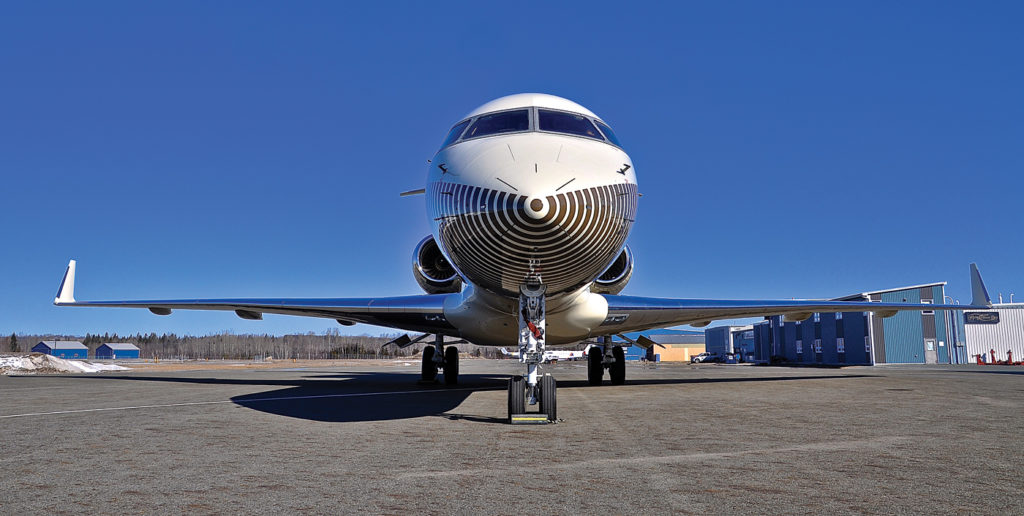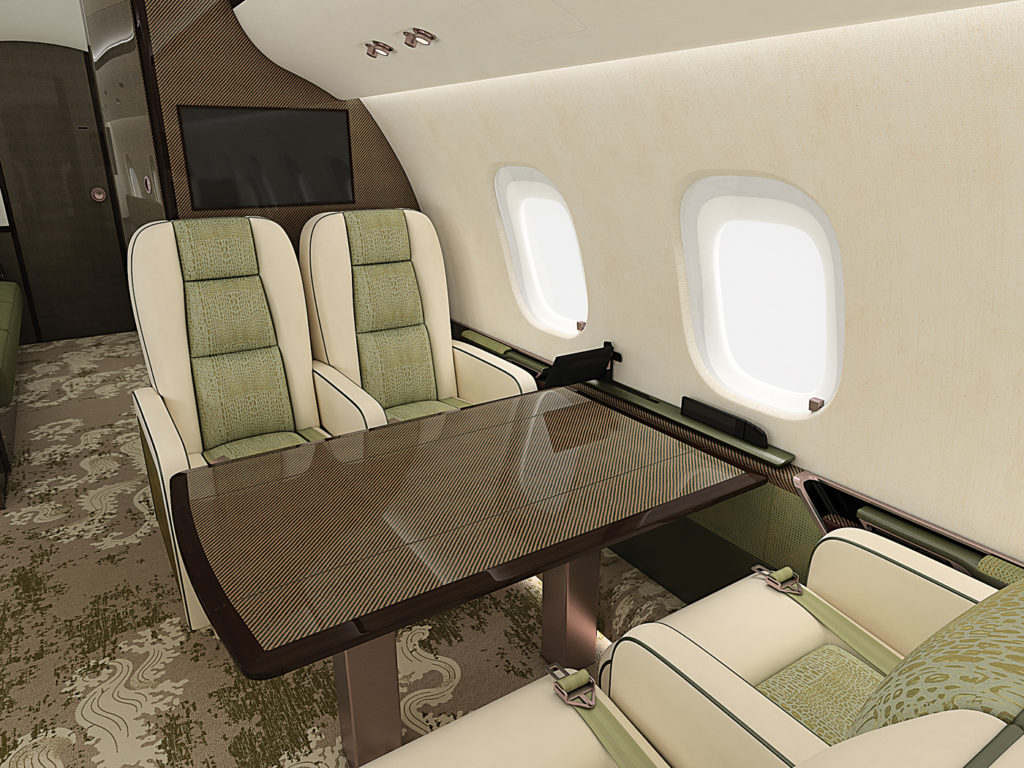Estimated reading time 9 minutes, 54 seconds.
Editor’s Note: Is your corporate aircraft looking a bit tired these days? Have you ever wondered what’s involved in a custom refurbishment? We invited Peterborough, Ont.-based Flying Colours to walk us through a project that illustrates the custom design process, with a twist. In the second installment of this two-part series, we learn how pre-engineered external components combined with internal creativity and expertise to breathe new life into an aging Global Express business jet.
At the end of March 2017, Flying Colours Corp. delivered the industry’s first jet that had undergone a complete cabin conversion incorporating the new pre-engineered components manufactured by Inairvation, the 50/50 joint venture between Germany-based Lufthansa Technik (LHT) and F.List of Austria.

In less than five months, the classic 2003 Bombardier Global Express underwent a complete internal and external transformation that brought style and elegance to the otherwise outdated interior. At the same time, the exterior fuselage was treated to one of the most striking aircraft paint schemes Flying Colours has ever produced.
Interior installation
The Peterborough, Ont., aircraft services business has had over three decades of experience outfitting, completing, maintaining and revamping aircraft interiors and exteriors. However, this was the first time the team had worked in conjunction with a European company that was providing finished components to be incorporated into the design.
“This was different territory for us in terms of having to liaise extensively with our partners,” said Sean Gillespie, executive vice-president at Flying Colours. “We have all the expertise required for completions and conversions in-house. That is one of our core competencies as a business, to be able to service all the client’s needs under one roof. We are proud of our internal skills, but it was also exciting to begin work on such an interesting project with Inairvation.
“We recognized right at the start the importance of regular communication with Inairvation,” he continued, adding that Flying Colours had to adjust its regular work schedule to accommodate the external communication. “Overhauling any cabin is invariably a complex process requiring well executed project management, technical skills, know-how, and the ability to turn theory into practicality. Clear internal communication is imperative, but this time we needed to incorporate agility, flexibility and a few moments of innovative thinking to make the external communication process work, too.

“The great thing is that the Inairvation team was very easy to work with. We spoke regularly, which meant that the varying groups involved were fully aware of any issues and their role within the planning,” said Gillespie. “We also had to liaise frequently to ensure the new nice HD CMS/IFE [high definition cabin management system/in-flight entertainment] system, and customized side ledges, worked with the existing aircraft systems and airframe. We were able to share any concerns and resolve them together directly.”
Over the years, Flying Colours has worked on many Global Express projects. This experience proved to be a real advantage, but there are always challenges integrating new technology into an older aircraft. The correct engineering process is essential to completing the conversion successfully.
The first practical task for turning this project’s vision into reality involved engineers undertaking extensive surveying to ensure the various components, such as the new wiring, would work with the retained systems–and that the new structure would work on an older airframe.
“Substantiating all of this is very important. Planning up front, anticipating any issues, and then scheduling the work accordingly is a vital step for an effective conversion work schedule,” said Gillespie.
Once this step is complete, an efficient procurement process secures all parts needed to complete the work.
In parallel, initial modifications were taking place on the structure, readying the shell for its new components. Next up was the avionics wiring. This formed a major portion of the early work as the experts literally mapped out on paper the complex wiring that supports the avionics, lights, in-flight entertainment system, cabin controls, cabin environment and management system. It is this web of information that keeps the aircraft in the air and under control. To the uninitiated the design looks similar to a very complex family tree; to the experts, it is a clear vision of how the aircraft components connect.

At the same time, all around the Peterborough facility technicians were busy working on their specific tasks. The cabinetry team modified and finished the cabinets with a mix of an intricately patterned carbon fibre veneer which was unusually complemented by wood accents; the new Global 6000 seat frames were upholstered with exotic, embossed leathers; and the paint shop prepared for its most intricate job yet. The avionics team developed a newly designed ATG 5000 Gogo system to provide on board Wi-Fi. And the design engineering team had to integrate the nice HD CMS/IFE system components with the Inairvation side ledges.
Trialing the functionality of these new fittings formed the largest test phase of the whole conversion process. The newly installed LED lighting system had to be integrated into the cabin monuments. Each component’s functionality was examined to ensure the operational success of the new CMS system. This required further testing following major modifications to the galley, bulkheads and passenger service units. The new Wi-Fi system also necessitated extensive testing.
“We haven’t had to fit a Wi-Fi system on a classic Global Express before, although we’ve completed these systems on many other aircraft. However, as this was a first for this model we had to certify it and perform a testing personal electronic devices (TPED) test,” said Gillespie. This ensures that the addition of a new electronic system doesn’t negatively affect existing systems.
The frenzy of activity is all controlled through adept project management, which is the key to keeping the work on schedule. Daily meetings between all departments, and at all levels, as well as regular meetings with all key suppliers are essential. Flying Colours also maximizes lean manufacturing techniques which are designed to specifically improve efficiency and promote waste reduction working methods, which improve overall output. This helps reduce downtime for owners and operators and ensures top quality.

Yet, the project was not without a few challenges.
“We are very experienced at matching wooden veneers with their complex grains and patterns, but aligning the complex twill pattern of the carbon fibre proved to be a real challenge,” said Gillespie. “It was immensely intricate; it took real skill and patience. While wood often has distinct patterns, this was uniform; so strangely, it was even harder to align the pattern correctly. An area like the club seat configuration has so many different parts like tables, side ledges, personal electronic device holders and other small sections that it requires painstaking attention to detail to ensure the homogenous pattern.”
Flying Colours also had to carry out a lot of flammability testing.
“The new Inairvation components, the replacement materials on the cabin monuments, and new systems in other areas, meant we had to generate more than 90 burn tests, 40 of which were for the Inairvation side ledge components alone,” said Gillespie.
Exterior transformation
The paint shop encountered a whole new realm of complexity with the external paint scheme. Ramp presence is not necessarily the focus of most private jet owners who are looking for discretion and privacy. However, this owner wanted something completely unique, presenting Flying Colours with its most detailed external paint work specification to date.
As the name suggests, the company’s roots are in aircraft painting, and this ingrained knowledge was indispensable when it came to this particular project.

Working together with the owner, the Flying Colours design team created a genuinely unique look for the fuselage, incorporating uniform stripes on the lower half of the body, complemented by a honeycomb effect on the cabin door and nacelles. Once finalized, the paint team’s labour of love began in the dedicated paint shop at Flying Colours’ Peterborough facility. The existing paint was stripped from the fuselage using specialized chemicals. Once the process was completed, sanding and scuffing prepared the surface for the final applications by taking it back to the bare metal. In its naked state, sealant was applied and the metal prepared to ensure the paint would adhere after the initial primer was put on.
To create the final stripes and honeycomb effect required extreme patience. Each individual stripe needed to be measured; each honeycomb template had to be applied by hand, and the final edgings hand painted by brush.
“It was hugely labour intensive, taking about six weeks, including all the detailing, but the finished work looked incredible when it left the hangar,” said Gillespie proudly.

The final phases of completion required testing of all aircraft functionality over a two-week period, with the electrical modifications, including the new side ledges, representing the largest group of tests. In late March, the maintenance engineers gave the final seal of approval and returned the aircraft to service. Subsequent ground and flight testing was completed, before the final flight was made with the customer’s crew to ensure everything worked as expected.
“We were really pleased with this refurbishment; it is stunning inside and out, and firmly demonstrates just how skilled our team is. It was such a complex project with a number of new variables, including long-distance partners, components that hadn’t been used before, and a huge variety of materials,” said Gillespie.
“The aircraft flew directly to its owner who was thrilled with it. We were kind of sad to see it go, as it had been such a key focus at the facility, but we’re already in talks with the next client about the next Inairvation project, which we hope to announce at EBACE [the European Business Aviation Convention and Exhibition, held in May in Geneva, Switzerland].”
Jane Stanbury is director of marketing and communications for Flying Colours Corp.
See Part 1 of this article in the March/April 2017 issue of Skies, or online at this link.

